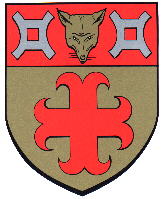Waldbillig: Difference between revisions
Knorrepoes (talk | contribs) (Created page with '{|width="100%" style="color:black; background-color:#ffffcc;" |width="15%"|50 px|left |width="70%" align="center" |'''Heraldry of the World<br>Civic heral…') |
Knorrepoes (talk | contribs) m (Text replace - "'''Origin/meaning :'''<br/>" to "====Origin/meaning====") |
||
| Line 9: | Line 9: | ||
[[File:waldbill.jpg|center]] | [[File:waldbill.jpg|center]] | ||
====Origin/meaning==== | |||
The arms were granted on June 13, 1984. | The arms were granted on June 13, 1984. | ||
Revision as of 06:52, 1 April 2012
| Heraldry of the World Civic heraldry of Luxembourg |
WALDBILLIG
Origin/meaning
The arms were granted on June 13, 1984.
During the early Middle Ages the territory of the present municipality was partly ruled by the Lords of Larochette, and partly by the Lords of Beaufort. This situation lasted until the Napoleonic times.
This historical division can be seen in the arms, as the lower part shows the cross of Larochette and the division of the shield is taken from the arms of the Lords of Beaufort.The two symbols in the top are described as water mill wheels, and symbolise the former water-mills in the Mellerdall area. The fox head symbolises the poem Reenert (canting renard=fox in French), written by Michel Rodange, native of Waldbillig.
Literature : Loutsch, J-C. et al.; Armorial communal du Grand-Duché de Luxembourg, Fisch, Luxembourg, 1989, 331 p.

